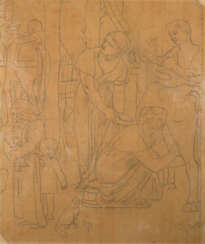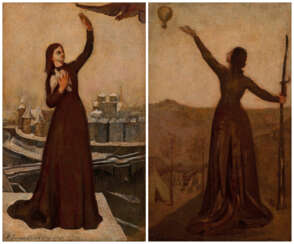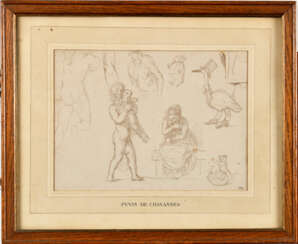chavan

Pierre Cécile Puvis de Chavannes, a prominent French painter, was known as "the painter for France." His influential mural paintings showcased a classicizing style, often referencing visions of Hellenistic Greece.
Puvis received numerous commissions for public and private institutions across France, with significant works in Amiens, Marseille, Lyon, Poitiers, and Paris. His success as a 'painter for France' stemmed from his ability to appeal to various ideologies of the time. In addition to murals, Puvis created easel paintings, some of which can be found in galleries worldwide. Despite his significance, he was not fully appreciated during his lifetime, and his work remains a subject of ongoing art criticism.


Pierre Cécile Puvis de Chavannes, a prominent French painter, was known as "the painter for France." His influential mural paintings showcased a classicizing style, often referencing visions of Hellenistic Greece.
Puvis received numerous commissions for public and private institutions across France, with significant works in Amiens, Marseille, Lyon, Poitiers, and Paris. His success as a 'painter for France' stemmed from his ability to appeal to various ideologies of the time. In addition to murals, Puvis created easel paintings, some of which can be found in galleries worldwide. Despite his significance, he was not fully appreciated during his lifetime, and his work remains a subject of ongoing art criticism.


Pierre Cécile Puvis de Chavannes, a prominent French painter, was known as "the painter for France." His influential mural paintings showcased a classicizing style, often referencing visions of Hellenistic Greece.
Puvis received numerous commissions for public and private institutions across France, with significant works in Amiens, Marseille, Lyon, Poitiers, and Paris. His success as a 'painter for France' stemmed from his ability to appeal to various ideologies of the time. In addition to murals, Puvis created easel paintings, some of which can be found in galleries worldwide. Despite his significance, he was not fully appreciated during his lifetime, and his work remains a subject of ongoing art criticism.


Pierre Cécile Puvis de Chavannes, a prominent French painter, was known as "the painter for France." His influential mural paintings showcased a classicizing style, often referencing visions of Hellenistic Greece.
Puvis received numerous commissions for public and private institutions across France, with significant works in Amiens, Marseille, Lyon, Poitiers, and Paris. His success as a 'painter for France' stemmed from his ability to appeal to various ideologies of the time. In addition to murals, Puvis created easel paintings, some of which can be found in galleries worldwide. Despite his significance, he was not fully appreciated during his lifetime, and his work remains a subject of ongoing art criticism.


Pierre Cécile Puvis de Chavannes, a prominent French painter, was known as "the painter for France." His influential mural paintings showcased a classicizing style, often referencing visions of Hellenistic Greece.
Puvis received numerous commissions for public and private institutions across France, with significant works in Amiens, Marseille, Lyon, Poitiers, and Paris. His success as a 'painter for France' stemmed from his ability to appeal to various ideologies of the time. In addition to murals, Puvis created easel paintings, some of which can be found in galleries worldwide. Despite his significance, he was not fully appreciated during his lifetime, and his work remains a subject of ongoing art criticism.


Pierre Cécile Puvis de Chavannes, a prominent French painter, was known as "the painter for France." His influential mural paintings showcased a classicizing style, often referencing visions of Hellenistic Greece.
Puvis received numerous commissions for public and private institutions across France, with significant works in Amiens, Marseille, Lyon, Poitiers, and Paris. His success as a 'painter for France' stemmed from his ability to appeal to various ideologies of the time. In addition to murals, Puvis created easel paintings, some of which can be found in galleries worldwide. Despite his significance, he was not fully appreciated during his lifetime, and his work remains a subject of ongoing art criticism.


Pierre Cécile Puvis de Chavannes, a prominent French painter, was known as "the painter for France." His influential mural paintings showcased a classicizing style, often referencing visions of Hellenistic Greece.
Puvis received numerous commissions for public and private institutions across France, with significant works in Amiens, Marseille, Lyon, Poitiers, and Paris. His success as a 'painter for France' stemmed from his ability to appeal to various ideologies of the time. In addition to murals, Puvis created easel paintings, some of which can be found in galleries worldwide. Despite his significance, he was not fully appreciated during his lifetime, and his work remains a subject of ongoing art criticism.


Pierre Cécile Puvis de Chavannes, a prominent French painter, was known as "the painter for France." His influential mural paintings showcased a classicizing style, often referencing visions of Hellenistic Greece.
Puvis received numerous commissions for public and private institutions across France, with significant works in Amiens, Marseille, Lyon, Poitiers, and Paris. His success as a 'painter for France' stemmed from his ability to appeal to various ideologies of the time. In addition to murals, Puvis created easel paintings, some of which can be found in galleries worldwide. Despite his significance, he was not fully appreciated during his lifetime, and his work remains a subject of ongoing art criticism.


Pierre Cécile Puvis de Chavannes, a prominent French painter, was known as "the painter for France." His influential mural paintings showcased a classicizing style, often referencing visions of Hellenistic Greece.
Puvis received numerous commissions for public and private institutions across France, with significant works in Amiens, Marseille, Lyon, Poitiers, and Paris. His success as a 'painter for France' stemmed from his ability to appeal to various ideologies of the time. In addition to murals, Puvis created easel paintings, some of which can be found in galleries worldwide. Despite his significance, he was not fully appreciated during his lifetime, and his work remains a subject of ongoing art criticism.



Pierre Cécile Puvis de Chavannes, a prominent French painter, was known as "the painter for France." His influential mural paintings showcased a classicizing style, often referencing visions of Hellenistic Greece.
Puvis received numerous commissions for public and private institutions across France, with significant works in Amiens, Marseille, Lyon, Poitiers, and Paris. His success as a 'painter for France' stemmed from his ability to appeal to various ideologies of the time. In addition to murals, Puvis created easel paintings, some of which can be found in galleries worldwide. Despite his significance, he was not fully appreciated during his lifetime, and his work remains a subject of ongoing art criticism.


Pierre Cécile Puvis de Chavannes, a prominent French painter, was known as "the painter for France." His influential mural paintings showcased a classicizing style, often referencing visions of Hellenistic Greece.
Puvis received numerous commissions for public and private institutions across France, with significant works in Amiens, Marseille, Lyon, Poitiers, and Paris. His success as a 'painter for France' stemmed from his ability to appeal to various ideologies of the time. In addition to murals, Puvis created easel paintings, some of which can be found in galleries worldwide. Despite his significance, he was not fully appreciated during his lifetime, and his work remains a subject of ongoing art criticism.


Ker-Xavier Roussel was a French painter, renowned for his distinctive post-impressionist style and his affiliation with the Nabis, an avant-garde artist group. Born in 1867, Roussel's artistic journey began in his teens and continued robustly into the 20th century, leaving a legacy celebrated for its mythological and bucolic themes.
Roussel's art is characterized by its vivid portrayal of mythological scenes and landscapes, often infused with a sense of eroticism and joy. His work frequently depicts Greek myths set against the backdrop of the Mediterranean, featuring figures like women, nymphs, centaurs, and fauns. These large, brightly colored paintings, such as "Rural Festival, Summer" and "The Seasons of Life," marked a departure from the smaller formats typical of the Nabis, showcasing his evolution towards a more expansive and expressive style.
A master of pastels, Roussel's work from the 1890s, such as "La Barrière," displayed at the Musée d'Orsay, reflects the Nabi style with its Japanese print influences, absence of perspective, and contrasting values. His later works, created between 1930 and 1944, often depicted violent mythological deaths, revealing a darker aspect of his artistic expression.
Roussel's contributions extended beyond canvas, as he created large paintings for public spaces and private clients, including a significant panel for the Palais des Nations in Geneva and the front curtain of the Théâtre des Champs-Élysées. His recognition peaked in the 1930s, with a multi-panel scheme for the Palais de Chaillot and winning the Carnegie Prize for art in 1926.
Despite a period of obscurity, Roussel's work regained attention through exhibitions like "Ker-Xavier Roussel, Private Garden, Dreamed Garden" at the Musée des Impressionnismes in Giverny, showcasing his significant contributions to art history.
For art collectors and experts, understanding Roussel's work offers insights into the evolution of post-impressionism and the Nabis' influence on modern art. His unique blend of mythological themes and vibrant landscapes represents an important chapter in art history. For those interested in exploring Roussel's work further or keeping updated on related art sales and auctions, signing up for updates is a valuable opportunity to deepen your engagement with this influential artist's legacy.

.jpg)
Jean-François Millet was a French artist and one of the founders of the Barbizon school in rural France. Millet is noted for his paintings of peasant farmers and can be categorized as part of the Realism art movement. Toward the end of his career, he became increasingly interested in painting pure landscapes. He is known best for his oil paintings but is also noted for his pastels, conte crayon drawings, and etchings.


Maurice Denis, a French painter and writer, was an influential figure in the transition from impressionism to modern art. Born on November 25, 1870, in Granville, France, Denis's artistic journey began at the Académie Julian in Paris. Here, he met future collaborators like Paul Sérusier and Pierre Bonnard, with whom he later formed the Nabis group, a collective deriving its name from the Hebrew word "Nabi," meaning "Prophet".
Denis's style evolved from neoimpressionism, influenced by artists like Seurat, to a more decorative and colorful approach under the influence of Gauguin. This shift is evident in works like "Taches du soleil sur la terrace" (1890). He famously stated, "Art is no longer a visual sensation... it is a creation of our spirit," highlighting his belief in art as an idealistic expression, transcending mere imitation of nature.
Denis was also impacted by Japanese art, which influenced his compositions and styles, contributing to his unique and recognizable approach. His philosophy on art, encapsulated in his 1890 essay published in "Art et Critique," emphasized the importance of color and form in creating emotional depth, a notion that laid the groundwork for modernism. He argued that a painting's essence lies in its colors and composition, rather than its subject matter.
Throughout his career, Denis's work evolved towards a more classical approach. His involvement with the Ateliers d'Art Sacré, founded in 1919, demonstrated his interest in religious art and decoration. His notable works include "The Legend of Saint Hubert" (1897) and "The History of Music" for the Théâtre des Champs Elysées (1912-1913).
Tragically, Maurice Denis's life ended on November 13, 1943, when he was struck by a truck during the German occupation of Paris. However, his legacy endures through his contributions to modern art and symbolism, his influence on fellow artists, and his works displayed in various museums and galleries.
For collectors and art experts, Denis's work offers a unique glimpse into the evolution of modern art. His blend of symbolism, color, and form marks a significant shift in art history. To stay updated on new sales and auction events related to Maurice Denis's work, sign up for our newsletter. This subscription will keep you informed about the latest developments in the world of this remarkable artist.


Maurice Denis, a French painter and writer, was an influential figure in the transition from impressionism to modern art. Born on November 25, 1870, in Granville, France, Denis's artistic journey began at the Académie Julian in Paris. Here, he met future collaborators like Paul Sérusier and Pierre Bonnard, with whom he later formed the Nabis group, a collective deriving its name from the Hebrew word "Nabi," meaning "Prophet".
Denis's style evolved from neoimpressionism, influenced by artists like Seurat, to a more decorative and colorful approach under the influence of Gauguin. This shift is evident in works like "Taches du soleil sur la terrace" (1890). He famously stated, "Art is no longer a visual sensation... it is a creation of our spirit," highlighting his belief in art as an idealistic expression, transcending mere imitation of nature.
Denis was also impacted by Japanese art, which influenced his compositions and styles, contributing to his unique and recognizable approach. His philosophy on art, encapsulated in his 1890 essay published in "Art et Critique," emphasized the importance of color and form in creating emotional depth, a notion that laid the groundwork for modernism. He argued that a painting's essence lies in its colors and composition, rather than its subject matter.
Throughout his career, Denis's work evolved towards a more classical approach. His involvement with the Ateliers d'Art Sacré, founded in 1919, demonstrated his interest in religious art and decoration. His notable works include "The Legend of Saint Hubert" (1897) and "The History of Music" for the Théâtre des Champs Elysées (1912-1913).
Tragically, Maurice Denis's life ended on November 13, 1943, when he was struck by a truck during the German occupation of Paris. However, his legacy endures through his contributions to modern art and symbolism, his influence on fellow artists, and his works displayed in various museums and galleries.
For collectors and art experts, Denis's work offers a unique glimpse into the evolution of modern art. His blend of symbolism, color, and form marks a significant shift in art history. To stay updated on new sales and auction events related to Maurice Denis's work, sign up for our newsletter. This subscription will keep you informed about the latest developments in the world of this remarkable artist.


Émile-Jacques Ruhlmann, (sometimes called Jacques-Émile Ruhlmann), was a French furniture designer and interior decorator, who was one of the most important figures in the Art Deco movement. His furniture featured sleek designs, expensive and exotic materials and extremely fine craftsmanship, and became a symbol of the luxury and modernity of Art Deco. It also produced a reaction from other designers and architects, such as Le Corbusier, who called for simpler, functional furniture.









































































